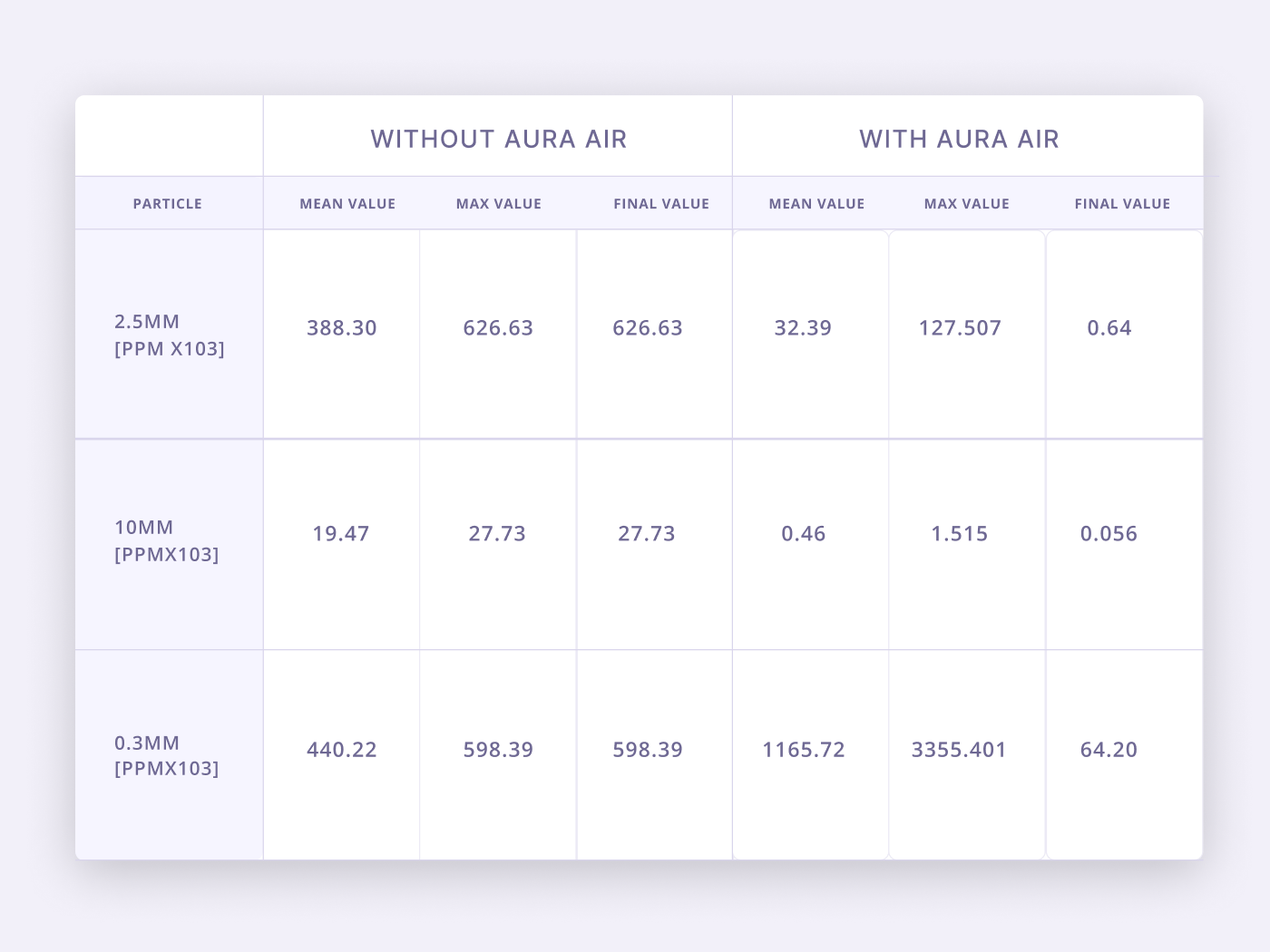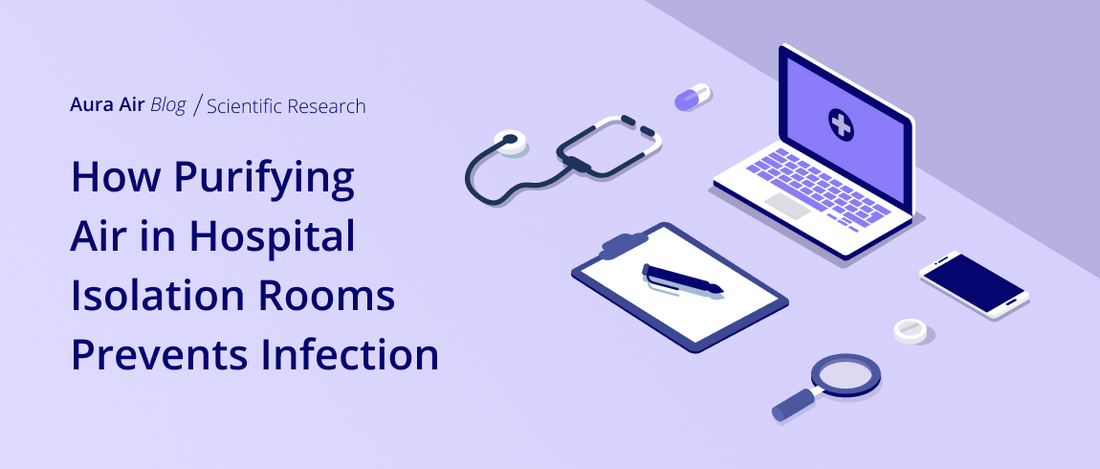Abstract
A common practice in hospitals is to isolate patients, whether to maintain their health or to prevent contamination from carrying a virus or contagious bacteria. The COVID-19 pandemic only intensified this need, so isolation rooms are used for patients to keep them safe. In this experiment, we examined the effects of using the Aura Air device as a tool for purifying the air in an isolation room at Sheba Medical Center’s medical simulation center (MSR). The results of the experiment revealed that the Aura Air device significantly reduced different PM levels, resulting in a reduced risk of infection.
Introduction
Particulate matter (PM) or also known as atmospheric aerosol particles are microscopic solid or liquid matter suspended in the atmosphere of the Earth. These particles include coarse particles with a diameter of 10 μm or less (PM10) and fine particles with a diameter of 2.5 μm or less (PM2.5). PM10 includes particles such as dust, pollen, and mold. PM2.5 includes particles such as combustion particles, organic compounds, metals, bacteria and more. The effects of inhaling particulate matter that has been widely studied in humans and animals include asthma, lung cancer, respiratory diseases, cardiovascular disease, premature delivery, birth defects, low birth weight and premature death (1). PM2.5 exposure may induce exacerbations of airway disease and contribute to the development of established type 2 immune responses in the airways with repeated exposures over time (2).
PM can be treated by improving ventilation, increasing ventilation effectiveness, and applying additional virus removal methods (such as HEPA filtration and UVGI disinfection). There is substantial evidence that smallpox, influenza, SARS, MERS, and rhinovirus are also transmitted via inhalation of aerosols. (3)COVID-19, similarly to other viruses, is capable of spreading through the air, and particulate matter (PM) could act as a carrier through the aerosol, conveying the virus and increasing its spread. (4)
Experimental Setup for Visualization Testing
In the experiment, the air quality was evaluated as a concentration of smoke particles with different volume. Visualization of airflow around the human patient simulator (HPS) was facilitated by marking air with smoke particles produced by a smoke generator and by using a well-established laser smoke visualization technique during the application. The experiment was conducted in an isolation room at the “Sheba” medical simulation center (MSR). The oil-based smoke particles are known to follow the airflow pattern precisely with negligible slip.
By using a high-definition video camera with an optical resolution of 1,440 pixels per video frame, the laser light sheet revealed smoke particles. Using a laser light sheet of nearly constant intensity, smoke particles were illuminated in the room environment and the data were collected and integrated by the particle counter. During the experiment, the same room with and without Aura Air’s device was tested under the same conditions for 7 minutes with a sample rate of 0.5 minutes.

The air flow simulations were conducted by “Buildwind” using ASAPP (Advanced Simulation for Airborne Pathogen Propagation). ASAPP estimates the viral load contained in respiratory droplets based on the latest scientific knowledge and predicts the time evolution of the viral load as the droplets interact with the surrounding environment. Simulations were only conducted for respiratory droplets that involved breathing, not coughing, sneezing, or speaking.
Testing was conducted at two different flow rates (350 m3/h, 175 m3/h), which are the maximum and half of the maximum flow rates, respectively. Measurements included the flow from the patient's mouth as well as the flow produced by the suction power of Aura.
Results
As shown in Figure 3, the effect of Aura is discernible for all three comparisons. There is an initial increase in particle concentration for the 6 measurements, but when Auras are used, a noticeable decrease can be observed, which started after about 2.5 minutes from the start of the measurement and decreased particle concentration significantly. In measurements without Aura instruments, a sustained increase in particle concentration was observed throughout the whole measurement period.
In the following table, we present numerical data that shows the mean value, the maximum value, and the final value of each of the measurements with and without the use of Aura's device.

As can be seen in Table 1, the mean value and the max value of 2.5µm and 10µm are much higher where there is no Aura Air in the isolation room and so is the final value. When examining those values for the 0.3µm particles, it is clear that the mean and max values are higher in the room with Aura Air, where the final value in the room with Aura Air (64.20x103 ppm) is significantly smaller than the one without Aura Air(598.39x103 ppm), indicating that the device has a major impact on particles concentration even though it dealt with higher starting concentration.

Air Flow Simulation
As can be seen in Figure 4 (Image a), the airflow simulation in the isolation room showed that there was a high airflow towards the Aura device, which suggests that most of the particles generated by the patient's breathing were captured. There are also small amounts of particles on the ceiling and walls of the room, as shown in Image b. When examining the air flow velocity lines it is clear that the Aura Air device produces a suction force that causes most of the particles to be sucked into it. The Aura Air device captured 80.5% of all particles in 4 minutes at the maximum flow rate (350 m3/h), and 77% of all particles at half the maximum flow rate (175 m3/h). In addition, according to the ASAPP 16.3% of the particles attached to the walls and ceiling and only 3.5% remain floating in the air. A reasonable assumption would be that given the duration of the test was longer, we would expect to see an even more significant decline in particle concentration.
In conclusion
Combined with the Sterionizer component, the advanced air purification and disinfection technology of Aura Air provides a significant line of defense against potential pollutants. This experiment illustrates the importance of using the Aura Air product for handling PM that could potentially serve as a carrier of viruses and bacteria, posing a threat to both patients and medical staff in the hospital at large, and in isolation rooms in particular.
Notes:
- Balmes, J. R. (2019). Do We Really Need Another Time-Series Study of the PM 2.5 –Mortality Association? New England Journal of Medicine, 381(8), 774–776.
- Qing, H., Wang, X., Zhang, N., Zheng, K., Du, K., Zheng, M., Li, Y., Chang, Y., Zhang, L., & Bachert, C. (2019). The Effect of Fine Particulate Matter on the Inflammatory Responses in Human Upper Airway Mucosa. American Journal of Respiratory and Critical Care Medicine, 200(10), 1315–1318. https://doi.org/10.1164/RCCM.201903-0635LE.
- Peng Z, Rojas ALP, Kropff E, Bahnfleth W, Buonanno G, Dancer SJ, Kurnitski J, Li Y, Loomans MGLC, Marr LC, Morawska L, Nazaroff W, Noakes C, Querol X, Sekhar C, Tellier R, Greenhalgh T, Bourouiba L, Boerstra A, Tang JW, Miller SL, Jimenez JL. Practical Indicators for Risk of Airborne Transmission in Shared Indoor Environments and Their Application to COVID-19 Outbreaks. Environ Sci Technol. 2022 Jan 18;56(2):1125-1137.
- Comunian, S., Dongo, D., Milani, C., & Palestini, P. (2020). Air Pollution and COVID-19: The Role of Particulate Matter in the Spread and Increase of COVID-19 s Morbidity and Mortality. International Journal of Environmental Research and Public Health, 17(12), 1–22.



